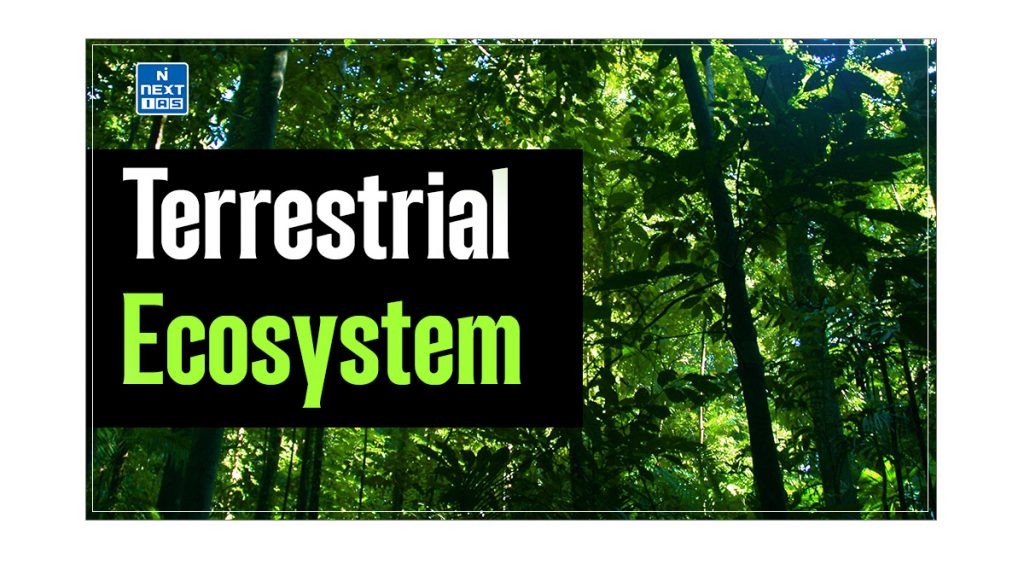
Terrestrial Ecosystems, with their diverse types and intricate components, are vital for the sustenance of life on Earth. A thorough understanding of these ecosystems is essential for comprehending ecological principles and addressing environmental challenges. This article aims to study in detail the Terrestrial Ecosystem, its meaning, and various types, including Forest Ecosystems, Grassland Ecosystems, Desert Ecosystems, Tundra Ecosystems, Mountain Ecosystems and Ghats Ecosystems.
What is Ecosystem?
- An ecosystem is a functional unit of nature where a community of living organisms interact among themselves and with the surrounding physical environment.
- An Ecosystem varies greatly in size and may be as large as a forest or sea or as small as a small fishpond, which provides a home for plants and other small animals.
Read our detailed article on the Basic Concepts of Ecosystem.
What is Terrestrial Ecosystem?
Terrestrial ecosystems are those ecosystems that are found on the land, i.e. the interactions between the living and the non-living parts of an ecosystem take place on the land masses.
Types of Terrestrial Ecosystems
Broadly, there are of four types of terrestrial ecosystems:
- Forest Ecosystems,
- Grassland Ecosystems,
- Desert Ecosystems, and
- Tundra Ecosystems.
Apart from them, there are some other types of terrestrial ecosystems that are found in India, such as – Mountain Ecosystem, and Ghats Ecosystem.
Each of these terrestrial ecosystems is discussed in detail in the sections that follow.
Forest Ecosystem
- A forest is a large area covered predominantly with trees and undergrowth.
- This is a type of terrestrial ecosystem that supports the rich growth of trees.
- Depending upon the density of trees, forests can be categorised into two types – dense forests and open forests.
- Forests are spread over approximately 30 per cent of the world’s land.
- Examples: tropical rainforests, coniferous forests etc.
Grassland Ecosystem
- A grassland is a type of terrestrial ecosystem that is characterized by vast open spaces dominated by grasses and other herbaceous plants, with few or no trees.
- Grasslands are found in those regions that have the ability to support vegetation but not to the extent of supporting big trees.
- These are the intermediate stages (seral stage) of ecological succession, culminating finally in forested areas.
- Important Grasslands of the world are as follows:
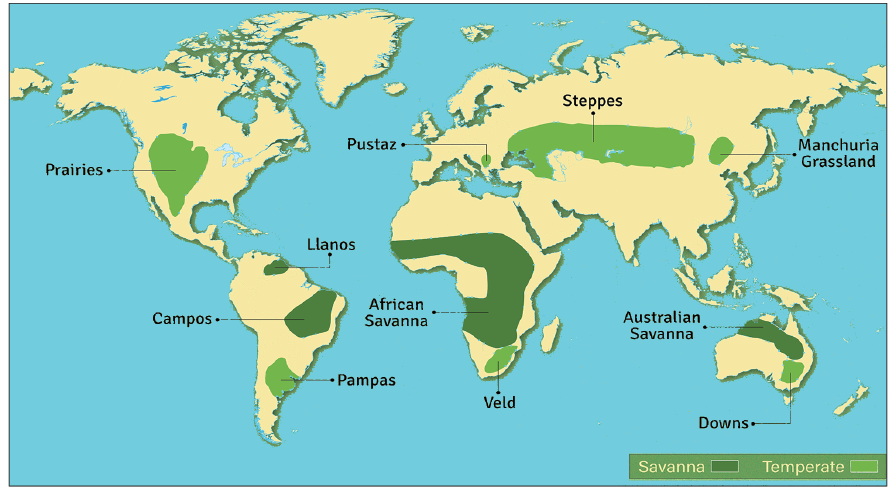
Tropical Grasslands
- There are regions in the tropical area that do not receive enough rainfall to support extensive tree cover, thus forming grasslands.
- These grasslands are also known as Savannah.
- These areas are dry but not as much as the desert areas. For example, Sahel is south of the Sahara, in East Africa, and in Australia.
Temperate Grasslands
- These grasslands are found in the mid latitude region and in the interior parts of the continents where the rainfall is low to moderate.
- These grasslands are known by different names in different regions of the world, such as
- Pampas in Argentina,
- Downs in Australia,
- Prairies in Central North American Plains,
- Pustaz in Hungary,
- Steppes in Russia, and
- Velds in South Africa.
- The annual precipitation ranges from 25 cm to 75 cm, most of which is in the form of snow, and temperature variation is high as these regions experience hot summer and cold winters.
Desert Ecosystem
- Deserts are those regions that receive an extremely low amount of rainfall (less than 25 cm annually) resulting in less vegetation compared to humid areas.
- This type of terrestrial ecosystem experiences a wide range of temperature and climate variations.
- The Desert ecosystem can again be categorised into two types: Hot deserts and Cold deserts.
- Some of the important deserts of the world are as follows.
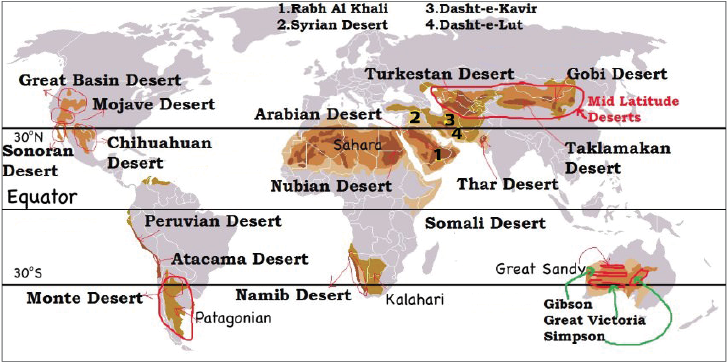
Hot Deserts
- Rainfall in these terrestrial ecosystems is generally too low (below 25 cm) to support proper vegetation.
- The soil is also coarse with good drainage so most of the rain water percolates into the soil.
- Examples of hot deserts include Kalahari (south-west Africa), Sahara (North Africa), Monte (Argentina) etc.
- In India, it is found in the Thar region of Rajasthan, extending into some parts of Haryana, Punjab and Gujarat.
- It has long sandy plains with changing sand dunes.
- It has long sandy plains with changing sand dunes.
Cold Deserts or Temperate Deserts
- The cold deserts are mainly found in higher latitude regions or the higher altitudes in tropical areas.
- Rainfall is scant and thus dry conditions prevail which may be due to remoteness from the coasts or presence of high mountains separating the desert from the coast.
- In India, the Cold Desert is situated in the Western Himalayas.
- It stretches from Ladakh in the north to Kinnaur (Himachal Pradesh) in the south.
Tundra Ecosystem
- These ecosystems are found in those areas that have long severe cold winters and very short cool summers.
- Tundra means ‘barren land’ because it is extremely hard to survive in these conditions.
- These terrestrial ecosystems have very low precipitation of less than 25 cm, and that takes place in the form of snow.
- There are 2 types of Tundra: Arctic Tundra and Alpine Tundra.
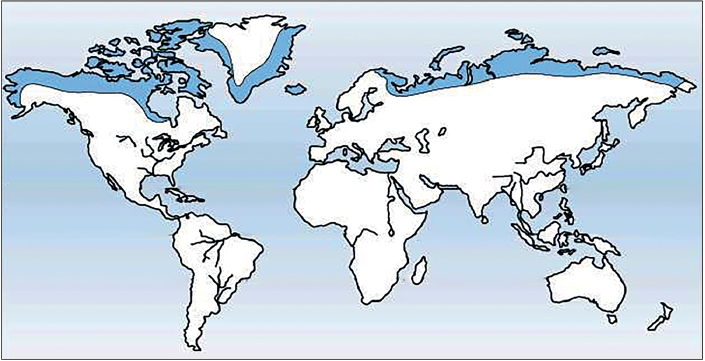
Arctic Tundra
- As the name suggests, this terrestrial ecosystem is located in close proximity to the Arctic Circle.
- A unique characteristic of this tundra is that it’s a permafrost region, i.e. even the soil is permanently frozen here, except the top layer which thaws in the summer season.
- During the summer, snow melts and percolates in the upper layer but cannot percolate into the permanently frozen soil.
- Thus, the top layers is saturated with water. Also, this region receive very low amount of sunlight during the whole year.
Alpine Tundra
- These are found in high mountains above the tree line at all latitudes.
- This terrestrial ecosystem does not contain trees, as it is too cold and windy to support any tree system.
- The average elevation of occurrence of Alpine Tundra is generally higher near the equator as compared to that at the poles.
- This is due to the earth’s bulge at the equator.
Tundra in India
- In India, these forests are found in the highest reaches of the Himalayas, above 3600 meters altitude.
- As we move up the mountain, the conditions become harsher for tree growth and thus, the plant shows stunted growth.
- Important trees in this terrestrial ecosystem include silver fir, pine, juniper, and birch.
- Higher up the reaches, alpine grasslands are found as the condition is not suitable for tree growth.
- Vegetation like lichen and mosses are also found in high altitudinal regions.
Mountain Ecosystem
- A mountain ecosystem refers to the complex network of living organisms and their physical environment found in mountainous regions.
- These terrestrial ecosystems are characterised by steep terrain, varying altitudes, and often harsh climatic conditions, including lower temperatures, high winds, and reduced oxygen levels as altitude increases.
- The Himalayan mountain system is an important feature of the Indian subcontinent as it plays an important role in imparting the region a distinct identity.
- They act not only as physical barriers but also as a climatic, drainage and cultural divide.
- However, there are large-scale regional variations within the mountain system and for this reason, the mountain system can be divided into various subdivisions based on relief, alignment of ranges and other factors.
Read our detailed article on the Himalayas.
Ghats Ecosystem
- The Ghats of India are the two mountain ranges on the eastern and western edges of the Deccan Plateau.
- They have been classified into Western Ghats and Eastern Ghats.
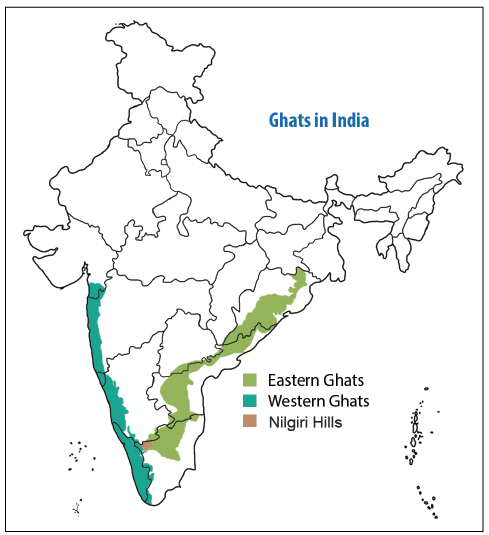
Western Ghats
- These hill ranges are continuous from the Tapti River in the north to Kanyakumari in the south.
- They run parallel to the west coast of India and are also known as Sahyadri.
- These areas receive orographic rainfall of about 100-500 cm from the Arabian Sea branch of the southwest monsoon.
- The western Ghats is very important for the peninsular rivers as it act as a source of most of the rivers flowing in this region.
- Coupled with warm atmosphere throughout the year, this terrestrial ecosystem support great wealth of biodiversity and thus counted among the 36 biodiversity hotspots of the world.
Eastern Ghats
- These ranges run parallel to the east coast and are a series of discontinuous hill ranges, with many great rivers cutting across them, including the Mahanadi, Godavari, and Krishna rivers.
- They receive 60-160 cm of rainfall.
- The ghats lie in tropical climates.
- The climate here varies from semi-arid to semi-humid and accordingly, the vegetation ranges from evergreen trees to dry savannas.
- This is the only region in India that boasts dry evergreen forests in India.
- The region is rich in biodiversity and particularly famous for a variety of medicinal plants including Acorus calamus, Aegle marmelos and Costus speciosus etc.
- The Papikonda National Park which lies in the northern section of the eastern ghats, north of the Godavari River, has moist deciduous and semi-evergreen forests.
Read our detailed article on the Western Ghats and Eastern Ghats.
Conclusion
Terrestrial Ecosystems are the life-supporting systems on land and form a crucial component of the earth. Understanding the characteristics, challenges, and importance of terrestrial ecosystems is essential for ensuring the good health of our planet and environment.
Frequently Asked Question (FAQ)
What are the examples of terrestrial ecosystems?
Some of the most prominent examples of terrestrial ecosystems include – Forest Ecosystems, Grassland Ecosystems, Desert Ecosystems, and Tundra Ecosystems.






